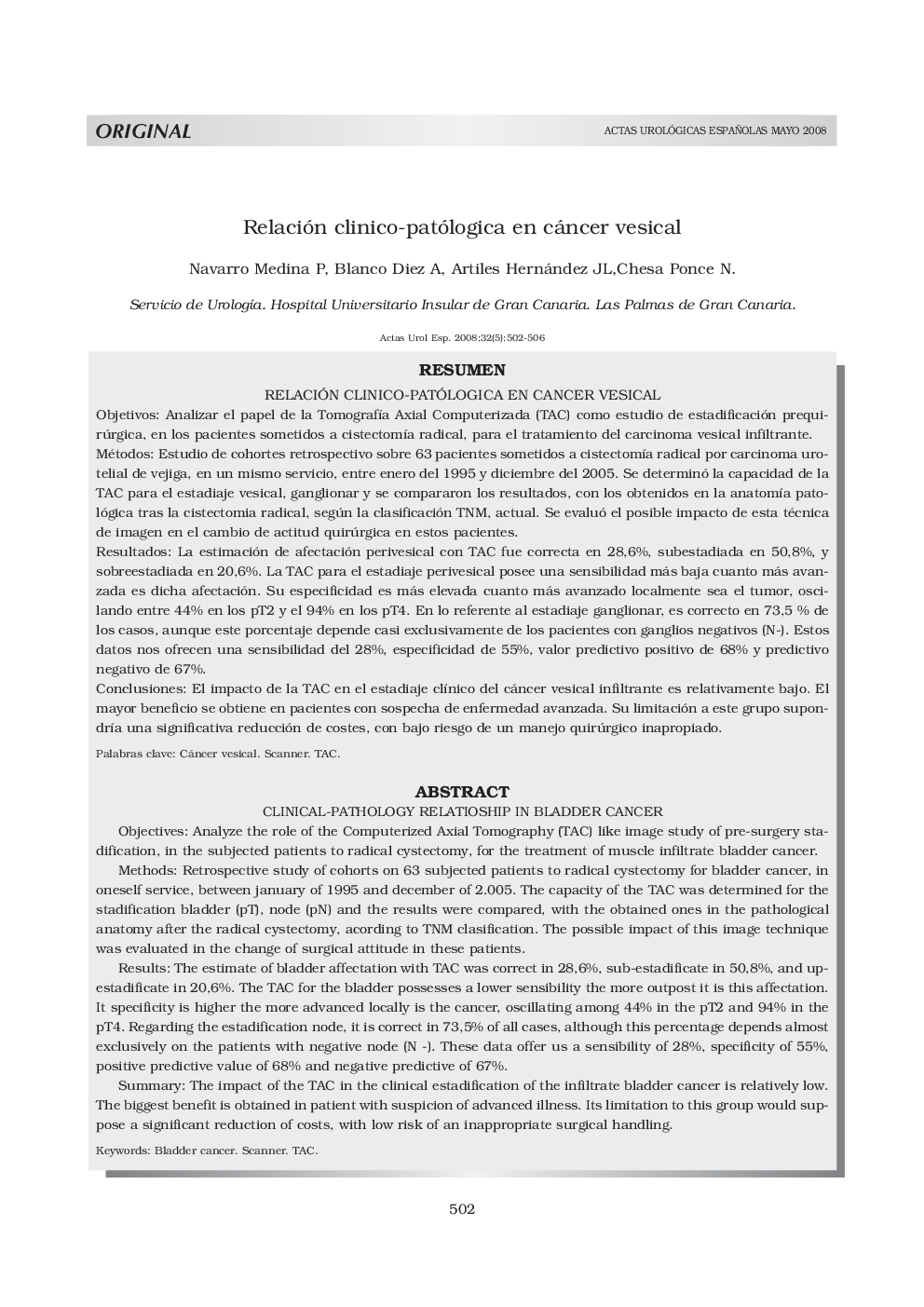| کد مقاله | کد نشریه | سال انتشار | مقاله انگلیسی | نسخه تمام متن |
|---|---|---|---|---|
| 3844655 | 1248161 | 2008 | 5 صفحه PDF | دانلود رایگان |

ResumenObjetivosAnalizar el papel de la TomografÃa Axial Computerizada (TAC) como estudio de estadificación prequirúrgica, en los pacientes sometidos a cistectomÃa radical, para el tratamiento del carcinoma vesical infiltranteMétodosEstudio de cohortes retrospectivo sobre 63 pacientes sometidos a cistectomÃa radical por carcinoma urotelial de vejiga, en un mismo servicio, entre enero del 1995 y diciembre del 2005. Se determinó la capacidad de la TAC para el estadiaje vesical, ganglionar y se compararon los resultados, con los obtenidos en la anatomÃa patológica tras la cistectomia radical, según la clasificación TNM, actual. Se evaluó el posible impacto de esta técnica de imagen en el cambio de actitud quirúrgica en estos pacientesResultadosLa estimación de afectación perivesical con TAC fue correcta en 28,6%, subestadiada en 50,8%, y sobreestadiada en 20,6%. La TAC para el estadiaje perivesical posee una sensibilidad más baja cuanto más avanzada es dicha afectación. Su especificidad es más elevada cuanto más avanzado localmente sea el tumor, oscilando entre 44% en los pT2 y el 94% en los pT4. En lo referente al estadiaje ganglionar, es correcto en 73,5 % de los casos, aunque este porcentaje depende casi exclusivamente de los pacientes con ganglios negativos (N-). Estos datos nos ofrecen una sensibilidad del 28%, especificidad de 55%, valor predictivo positivo de 68% y predictivo negativo de 67%ConclusionesEl impacto de la TAC en el estadiaje clÃnico del cáncer vesical infiltrante es relativamente bajo. El mayor beneficio se obtiene en pacientes con sospecha de enfermedad avanzada. Su limitación a este grupo supondrÃa una significativa reducción de costes, con bajo riesgo de un manejo quirúrgico inapropiado
ObjectivesAnalyze the role of the Computerized Axial Tomography (TAC) like image study of pre-surgery stadification, in the subjected patients to radical cystectomy, for the treatment of muscle infiltrate bladder cancerMethodsRetrospective study of cohorts on 63 subjected patients to radical cystectomy for bladder cancer, in oneself service, between january of 1995 and december of 2.005. The capacity of the TAC was determined for the stadification bladder (pT), node (pN) and the results were compared, with the obtained ones in the pathological anatomy after the radical cystectomy, acording to TNM clasification. The possible impact of this image technique was evaluated in the change of surgical attitude in these patientsResultsThe estimate of bladder affectation with TAC was correct in 28,6%, sub-estadificate in 50,8%, and upestadificate in 20,6%. The TAC for the bladder possesses a lower sensibility the more outpost it is this affectation. It specificity is higher the more advanced locally is the cancer, oscillating among 44% in the pT2 and 94% in the pT4. Regarding the estadification node, it is correct in 73,5% of all cases, although this percentage depends almost exclusively on the patients with negative node (N -). These data offer us a sensibility of 28%, specificity of 55%, positive predictive value of 68% and negative predictive of 67%SummaryThe impact of the TAC in the clinical estadification of the infiltrate bladder cancer is relatively low. The biggest benefit is obtained in patient with suspicion of advanced illness. Its limitation to this group would suppose a significant reduction of costs, with low risk of an inappropriate surgical handling
Journal: Actas Urológicas Españolas - Volume 32, Issue 5, 2008, Pages 502-506